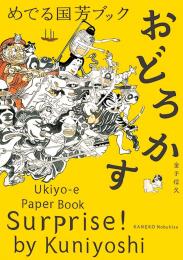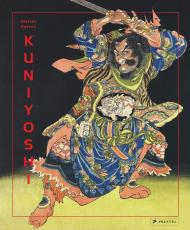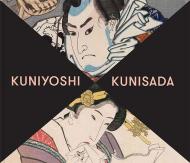Imagine life in Edo, Tokyo from the 17th-19th century, in the early modern period there were many Ukiyo-e shops which sold woodblock prints displaying then-current styles and fashions much like our fashion photography and magazines today.
Each Ukiyo-e work was sold individually people bought the beautifully printed sheets of paper to learn the trends of the day and/or to enjoy the art-works by displaying them on walls as interior decor.
Surprise! By Kuniyoshi covers a variety of subjects and themes ghosts, monsters, yokais and skulls, human beings in humorous or satiric situations any of which might shock or bring laughter to viewers in unexpected ways.
Surprise! By Kuniyoshi includes sixty reproductions of works by Utagawa Kuniyoshi (1792-1892), an outstanding Ukiyo-e great master these wonderful reproductions are removable, so that one may re-purpose the Ukiyo-e for whatever environment they choose.
The backside of each sheet includes elegantly simplified designs based on the featured Ukiyo-e designs.
Surprise! By Kuniyoshi is a must for Japanese art lovers, or anyone who might find interest in unusual and humorous delights.
About the Authors:
Nobuhisa Kaneko is a curatorial staff of the Fuchu Art Museum, Tokyo. He was born in 1962 in Tokyo and specializes in the history of Edo period (1600-1868) painting. He is the author of Tabi suru Edo kaiga: Rimpa kara dohanga made ( Travelling Edo painting: from Rinpa school to copperplate; PIE Books, 2010) and a co-author of Bessatsu Taiyo Edo Kaiga Nyumon (An Introduction to Edo Painting; Heibonsha, 2007. He has been actively conducting research, curating exhibitions, and writing in his endeavors to bridge the gap between the art of the past and people of today.
Kuniyoshi Utagawa (1797-1861) was one of the great masters of the Japanese ukiyo-e style of woodblock prints and painting. Born in 1797 to a silk dyer, he helped his father's business as a pattern designer. His drawing talent from an early age attracted the attention of the famous print master Toyokuni Utagawa, and Kuniyoshi became one of his apprentices in 1811. The range of Kuniyoshi's preferred subjects included many genres: landscapes, beautiful women, Kabuki actors, mythical animals, and cats. More than any other Japanese artist, Kuniyoshi depicted cats humorously and satirically, with great accuracy and careful observation.



